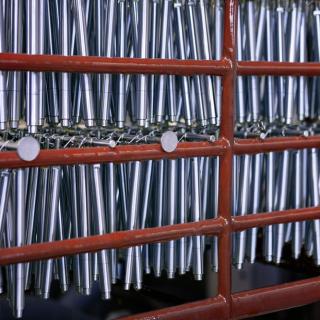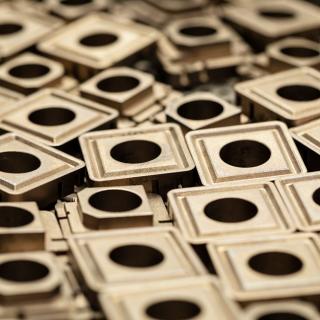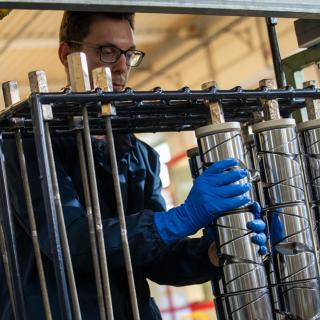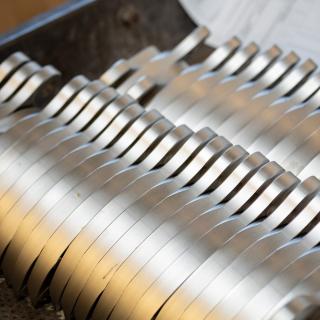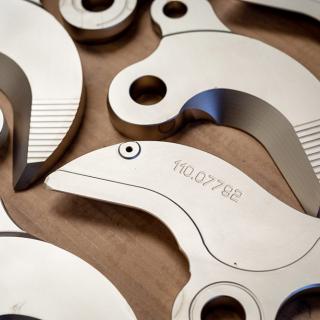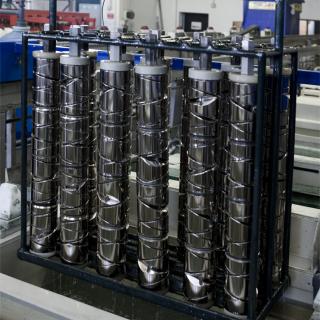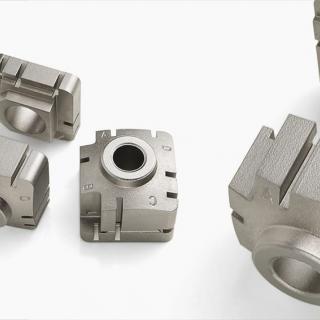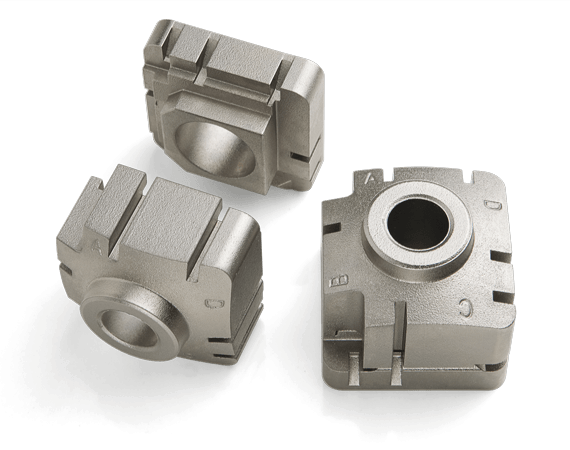
With the chemical nickel plating surface treatment we create a uniform nickel coating with low, medium or high phosphorus content on metal components made of aluminium, copper, iron alloys and on sintered metals. In contrast to electrolytic nickel plating, chemical nickel plating evenly coats parts with complex shapes, holes or undercuts with a uniformity of ±1 μm.
Chemical nickel-plating gives the surfaces a micro-hardness of 450 to 1,100 HV and a resistance of up to 1,000 hours in salt spray.
The electroless nickel coating is purely functional, but to meet the demands of its partners, Alfatech can give it an aesthetic value. Chemical nickel plating may be followed by dehydrogenation or heat treatments to stabilise the deposit and increase its hardness.
| Nickel Low phosphorus |
Nichel Medium Phosphorus |
Nichel High phosphorus |
|
|---|---|---|---|
| % phosphorus | 1-3 | 5-9 | 10-13 |
| Obtainable thicknesses (tolerance ±2 µm): | 4-120 µm | 4-120 µm | 4-120 µm |
| Coating uniformity: | ±1 μm | ±1 μm | ±1 μm |
| Knoop hardness as is (HK100) | 725-800 | 500-600 | 450-500 |
| Hardness after T.T. Knoop (HK100) | 900-1100 | 850-1000 | 850-950 |
| Magnetic properties as is | Magnetic | From slightly magnetic to magnetic | Non-magnetic |
| Melting range (°C) | 1250-1360 | 1100-1300 | 880-900 |
| Brass – 25 μm resistance at hour neutral salt spray |
≥ 300 | ≥ 1000 | ≥ 1000 |
| Carbon steel – 25 μm resistance to neutral salt spray |
≥ 96 hours | ≥ 180 hours | ≥ 240 hours |
% phosphorus: 1-3
Obtainable thicknesses (tolerance ±2 µm): 4-120 μm
Coating uniformity: ±1 μm
Knoop hardness as is (HK100): 725-800
Hardness after T.T. Knoop (HK100): 900-1100
Magnetic properties as is: Magnetic
Melting range (°C): 1250-1360
Brass – 25 μm resistance at hour neutral salt spray: ≥ 300
Carbon steel – 25 μm resistance to neutral salt spray hours: ≥ 96 hours
% phosphorus: 5-9
Obtainable thicknesses (tolerance ±2 µm): 4-120 μm
Coating uniformity: ±1 μm
Knoop hardness as is (HK100): 500-600
Hardness after T.T. Knoop (HK100): 850-1000
Magnetic properties as is: From slightly magnetic to magnetic
Melting range (°C): 1100-1300
Brass – 25 μm resistance at hour neutral salt spray: ≥ 1000
Carbon steel – 25 μm resistance hours neutral salt spray: ≥ 180 hours
% phosphorus: 110-13
Obtainable thicknesses (tolerance ±2 µm): 4-120 μm
Coating uniformity: ±1 μm
Knoop hardness as is (HK100): 450-500
Hardness after T.T. Knoop (HK100): 850-950
Magnetic properties as is: Non-magnetic
Melting range (°C): 880-900
Brass – 25 μm resistance at hour neutral salt spray: ≥ 1000
Carbon steel – 25 μm resistance hours neutral salt spray: ≥ 240 hours
In this section you can download the PDF for the specific process.
To date, about 40 different types of nickel chemicals are known, and they are commonly divided into acid and alkaline baths. Alkaline baths are defined as baths with pH > 7.00 and acid baths as pH < 7.00. More generally, they are subdivided by the amount of phosphorus they contain, into low, medium and high phosphorus electroless nickel plating.
There is no nickel plating that is better than others each of these families differs according to the scope of application of the part.
Chemical nickel plating is a chemical reaction, which takes place thanks to a precise product formulation and energy supplied in the form of heat.
The deposition process occurs by converting the nickel in the solution into metallic nickel; this reaction occurs directly on the surface of the metal which is coated in the process.
No current is used in the plating tank as this is a chemical process.
This prevents the tip effect, typical of electrolytic nickel, from occurring (increased thickness on part edges and ends, resulting in low thickness or lack of undercut and cavity coverage).
The result is a uniform, controlled and homogeneous deposit across all surface areas in contact with the solution.
Yes, it is essential to carry out stress-relieving treatments. The main problems that could interfere with chemical nickel plating are related to the presence of oxides on the surface of steels. The main example is calamine, which prevents chemical nickel plating from taking place.
It is also essential to carry out mechanical surface cleaning, such as brushing or sandblasting. Stress in the material may cause the material to fracture or even compromise the adhesion of the nickel-plating process. Any material or coating subjected to stress induces tension and therefore cracks. Cracks are the first cause that starts a corrosive process.
Normally the answer is yes, you need to pay attention to the possible layer of calamine that may form on the surface of the piece (see answer to FAQ “Do stresses in steels affect chemical nickel plating?”) or, if the heat treatment was carried out in a controlled atmosphere, check that the steel has not reached a degree of passivation such as to discourage surface treatment processes. If it cannot be controlled, sandblasting treatment is recommended beforehand.
For steels with a high carbon content, sandblasting treatment would be advisable before chemical nickel plating.
For steels with a high carbon content, sandblasting treatment would be advisable before chemical nickel plating.
No, a chemically nickel-plated and dehydrogenated part has a higher corrosion resistance than a heat-treated component.
During the heat treatment phase at maximum hardness, the parts are heated to the maximum temperature of approximately 315-380°C for a processing time of 4 to 12 hours. In this phase the electroless nickel deposit alters its physical state, the deposit increases in hardness, reaching a nanocrystalline conformation (the maximum hardness attainable for a high phosphorus electroless nickel deposit is 1100 HV).
If the furnace used for the treatment is not a vacuum furnace, the air in contact with the coating during the cooling phase gives rise to different colours called interference colours. The colouring can range from golden yellow to purple, but does not impact any functionality the coating; on the contrary, it ensures that maximum hardness is achieved. If unwanted, it can be removed by mechanical surface cleaning.
